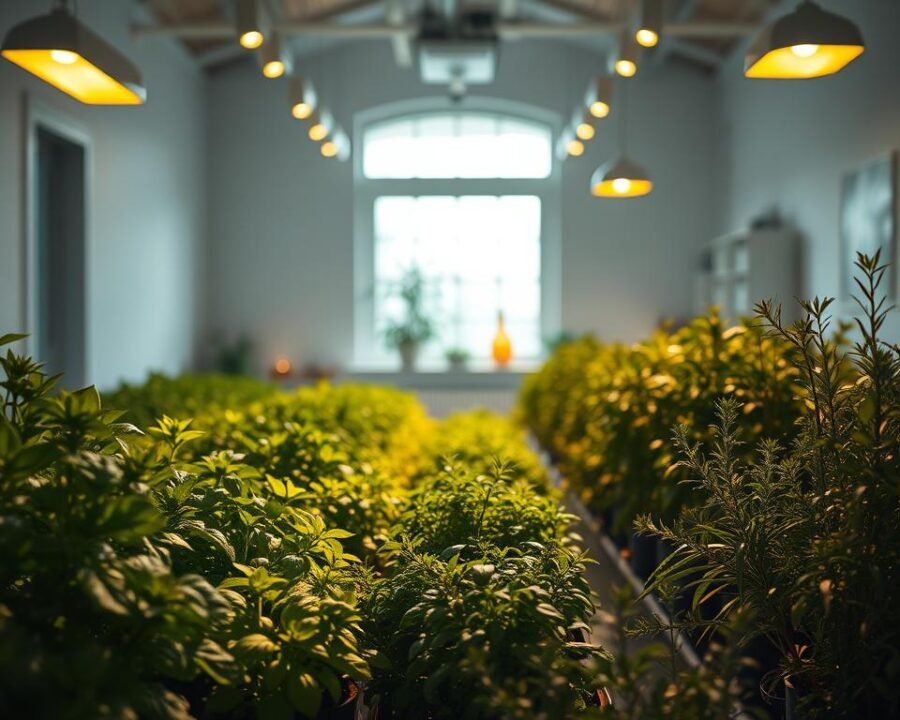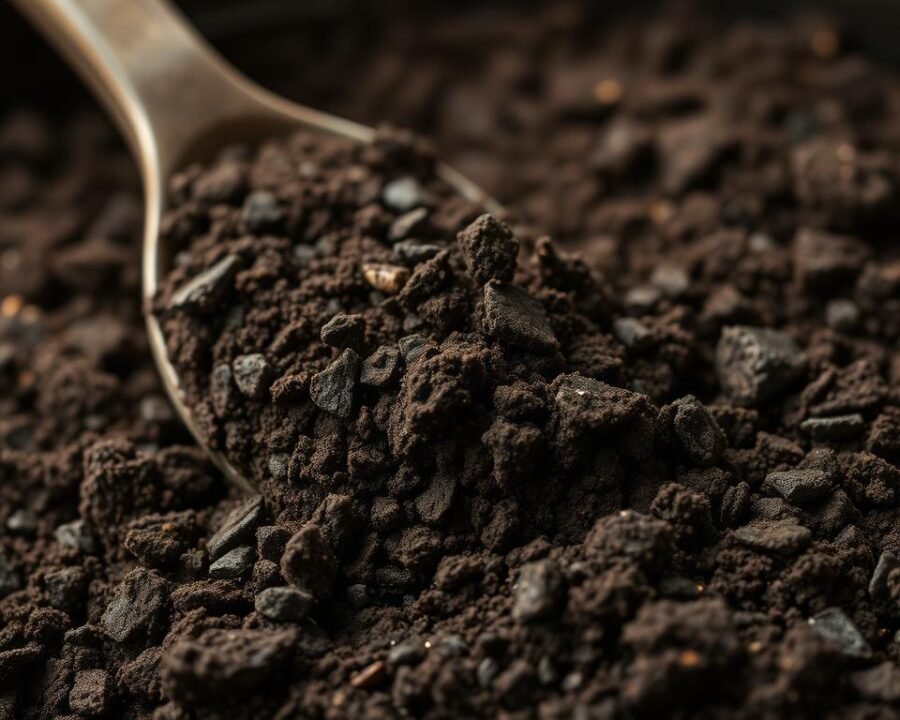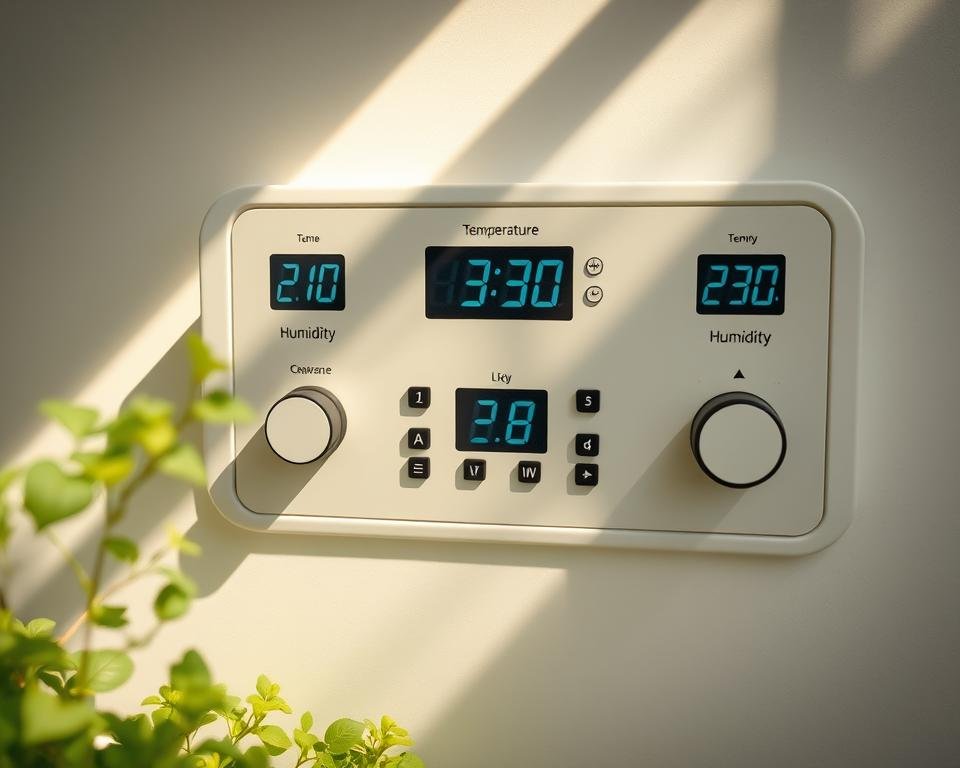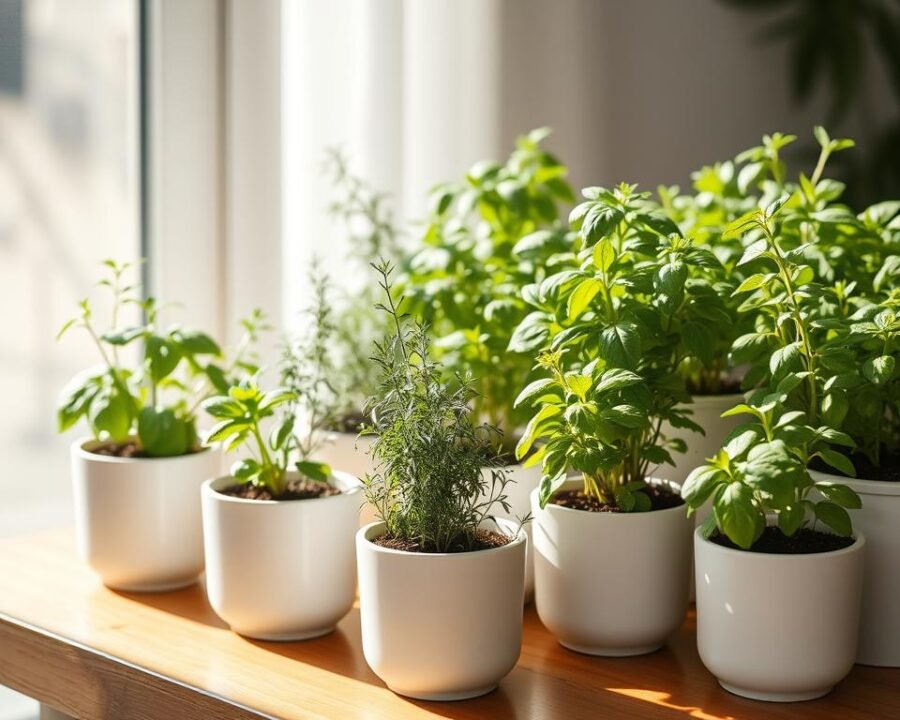There’s something magical about snipping fresh basil for pasta or garnishing a dish with homegrown cilantro. No more wilted store-bought bundles or last-minute grocery runs—just vibrant flavors at your fingertips. Whether you’re a seasoned gardener or a beginner, cultivating these fragrant greens is simpler than you think.
Even in small spaces, a thriving garden is possible. A sunny windowsill or compact planter can transform into a lush oasis. Imagine rosemary for roasted potatoes, mint for summer drinks, or thyme for soups—all grown right in your home.
Beyond taste, these plants purify the air and add natural beauty. Experts like Tovah Martin highlight their adaptability, making them perfect for any season. Let’s explore the joy of harvesting your own ingredients, saving money, and elevating everyday meals.
Key Takeaways
- Fresh herbs enhance meals and reduce grocery trips
- Compact setups work for apartments and small homes
- Year-round growth with proper light and care
- Cost-effective compared to store-bought options
- Adds aesthetic and aromatic benefits to living spaces
Why Grow Indoor Herb Plants?
Nothing beats the vibrant taste of freshly picked herbs in your favorite dishes. Cultivating them inside ensures a steady supply, no matter the season. Plus, it’s a budget-friendly way to add restaurant-quality flair to everyday meals.
Fresh Herbs Year-Round
Snow outside? No problem. With proper care, thyme and oregano thrive even in winter. Gardening expert Tovah Martin notes that cool temperatures (50–60°F) preserve their bold flavors.
Unlike outdoor gardens, containers let you harvest basil in December or mint for holiday teas. Rotate plants near sunny windows for nonstop growth.
Cost-Effective and Convenient
Store-bought bundles cost $3 each—homegrown sprigs? Just pennies. Over a year, you could save 65% on ingredients like rosemary and parsley.
Urban dwellers love compact setups. A single windowsill fits six pots, yielding enough for weekly pesto or garnishes.
Enhance Your Cooking
Fresh herbs pack more flavor than dried. Use one-third the amount to transform soups, salads, and dishes. Peppermint tea from your garden tastes brighter, too.
Their aroma also freshens the air, turning your kitchen into a fragrant retreat. It’s culinary and therapeutic magic in one.
Choosing the Right Herbs for Indoors
Not all herbs adapt equally well to life inside—choose wisely for success. Some varieties flourish on windowsills, while others struggle without outdoor conditions. Let’s explore the best picks for your space.
Best Herbs for Beginners
Oregano and mint top the list for easy-care plants. Mint spreads rapidly via surface roots, perfect for quick harvests. Oregano resists common pitfalls, with a 90% success rate in containers.
Other forgiving options:
- Berggarten sage: Compact and less prone to mildew.
- Lemon balm: Resilient in variable light.
- Chives: Regrow after cutting, ideal for steady use.
Herbs That Thrive in Low Light
North-facing windows? Try these shade-tolerant herbs:
- Parsley: Biennial in cooler homes.
- Thyme: Manages with 4 hours of sunlight.
- Cilantro: Prefers indirect light to avoid bolting.
Ann Stratton’s Zone 3 techniques show rotating pots weekly ensures even growth.
Herbs to Avoid Growing Indoors
Rosemary fails indoors 80% of the time due to poor air circulation. Sweet bay grows painfully slow, while dill attracts pests easily.
Basil demands attention—it flowers within two weeks, requiring frequent pruning. Stick to outdoor cultivation for these finicky varieties.
| Herb | Light Needs | Notes |
|---|---|---|
| Mint | Medium | Propagates fast |
| Thyme | Bright | Drought-tolerant |
| Parsley | Low | Biennial |
How to Grow Indoor Herb Plants Everyone Is Using
Whether you start with seeds or cuttings, each method offers unique rewards. Seeds teach patience, while transplants deliver instant gratification. Let’s explore the best path for your space and schedule.
Starting from Seeds vs. Transplants
Seeds take 6 weeks to mature but cost less. Use a heat mat to speed up germination by 70%. Transplants skip the wait—ideal for quick harvests.
Look for root-bound signs in store-bought plants: tangled roots or yellow leaves. Repot them into a wide container for a 300% better survival rate.
Propagating from Cuttings
Snip a 4-inch stem below a node. Place it in water, changing it weekly. Basil develops roots in 14 days. Laura from GardenAnswer recommends rooting hormone for woody herbs like rosemary.
Avoid overcrowded kits. The Gardener’s Supply Oslo Tabletop Kit fits 3–4 plants comfortably.
| Method | Time to Harvest | Best For |
|---|---|---|
| Seeds | 6+ weeks | Budget-friendly, variety options |
| Transplants | Immediate | Quick results, beginners |
| Cuttings | 2–3 weeks | Cloning favorites |
Pro tip: Organic fertilizers like fish emulsion encourage stronger roots. Synthetic options work faster but may burn delicate stems.
Light Requirements for Indoor Herbs
Proper lighting transforms a struggling plant into a thriving one. Without enough light, leaves turn pale and stems stretch awkwardly. Let’s explore how to match your space with the right illumination for vibrant herbs.

South- or West-Facing Windows
Sun-loving varieties like rosemary and oregano crave 6+ hours of direct light. A south-facing window delivers consistent brightness, ideal for Mediterranean species. West-facing spots work too but may need sheer curtains to prevent leaf scorch in summer.
Rotate pots weekly for even growth. Leggy stems signal insufficient exposure—move plants closer or add supplemental lighting.
North- or East-Facing Windows
Shade-tolerant parsley and mint manage with 4 hours of morning sun. For darker spaces, GE Grow Bulbs mimic natural spectra. Lux meter apps help measure intensity—aim for 2,000–5,000 lux.
Pro tip: Group herbs by light needs. A tiered stand maximizes limited window space efficiently.
Using Grow Lights
LED panels provide 12–14 hours of balanced rays without heat damage. Keep them 12 inches above foliage—adjust as plants grow. Compared to fluorescents, LEDs last longer and use 40% less energy.
- Clip-on models fit tight spaces
- Smart lights with sunrise simulators reduce shock
- Red/blue spectrum boosts chlorophyll production
In winter, extend daily exposure by 2 hours to compensate for weaker sunlight. Watch for leaf curl—it signals excessive intensity.
Selecting the Perfect Containers
The right container can make or break your herb-growing success. It’s not just about looks—proper drainage, size, and material impact your plants’ health. Let’s find the best fit for your space and style.
Drainage Is Key
Without drainage holes, roots drown in standing water. Add a 2-inch layer of gravel or perlite at the bottom. For store-bought pots without holes, drill three ¼-inch openings.
Pro tip: Self-watering pots, like Gardener’s Supply models, prevent overwatering. They’re ideal for busy growers or moisture-loving mint.
Size and Material Considerations
Match the pot to your plant’s needs:
- Basil: 6-inch diameter for shallow roots.
- Rosemary: 10-inch depth for taproots.
- Oregano: Wide containers to handle spreading roots.
Terra cotta breathes but dries fast—perfect for drought-tolerant thyme. Plastic retains moisture for basil. Fabric pots promote air pruning but need frequent watering.
| Material | Best For | Drawbacks |
|---|---|---|
| Terra cotta | Mediterranean herbs | Heavy, fragile |
| Ceramic | Decorative displays | Poor insulation |
| Fabric | Root health | High maintenance |
For small spaces, stackable vertical garden systems maximize yield. Just ensure shelves can handle the weight—ceramic pots add up fast!
Soil and Potting Mix Essentials
The secret to thriving herbs lies beneath the surface—your soil mix makes all the difference. Get it right, and your garden will reward you with lush growth and bold flavors. The wrong blend? Expect droopy leaves and stunted progress.

Fast-Draining Mixes for Mediterranean Herbs
Rosemary and thyme hate wet feet. A 50/50 blend of cactus mix and perlite keeps their roots oxygenated. Aim for a pH of 6.0–7.0—Espoma’s Organic Cactus Mix nails this balance.
Signs your mix drains too slowly:
- Yellowing lower leaves
- Mold on soil surface
- Soggy pot base after watering
Rich Soil for Basil and Mint
These thirsty herbs crave moisture. Mix compost with potting soil (3:1 ratio) and top-dress with worm castings monthly. Skip peat-heavy blends—they compact over time, choking roots.
| Herb Type | Ideal Mix | Feeding Tip |
|---|---|---|
| Mediterranean | 50% cactus mix, 50% perlite | Slow-release fertilizer every 3 months |
| Basil/Mint | 75% potting soil, 25% compost | Compost tea every 2 weeks |
Pro tip: Mycorrhizal fungi added to the soil boost nutrient uptake by 30%. Repot every 18–24 months to refresh the medium.
Watering Your Indoor Herbs
Mastering moisture levels unlocks lush growth in potted herbs. Too much water drowns roots, while too little stresses plants. We’ll share pro techniques to hit the sweet spot.
Finding the Right Frequency
The finger test never fails. Insert it up to the second knuckle—if soil feels dry, it’s time to hydrate. Mint breaks this rule, craving consistently damp conditions.
Seasonal adjustments matter:
- Summer: Check every 2-3 days
- Winter: Wait 5-7 days between sessions
- Rosemary: Tolerates 10-day droughts
Spotting Trouble Early
Soggy roots show up as yellow leaves. Basil develops blistered foliage (edema) from overhydration. For precision, try a soil probe or Bluetooth sensor like the Xiaomi Flora.
Watering methods compared:
| Technique | Best For | Tip |
|---|---|---|
| Bottom-up | Deep-rooted thyme | Prevents crown rot |
| Top-down | Mint clusters | Flushes salt buildup |
Pro move: Terracotta pots wick away excess moisture naturally. Pair them with humidity trays for tropical varieties.
Temperature and Humidity Needs
Keeping your leafy friends happy means balancing warmth and moisture just right. Most herbs thrive in conditions similar to their native habitats—think Mediterranean breezes or tropical mornings. Ignore these needs, and you’ll see sluggish growth or brittle leaves.

Ideal Temperature Ranges
Rosemary loves cooler nights (50–60°F), while basil sulks below 65°F. Here’s a quick guide:
| Herb | Day Temp | Night Temp |
|---|---|---|
| Mint | 65–70°F | 55–60°F |
| Oregano | 70–75°F | 50–55°F |
| Basil | 75–85°F | 65°F+ |
Pro tip: Avoid placing plants near drafty windows or doors. A ThermoPro sensor helps monitor tricky spots.
Managing Humidity Indoors
Dry air crisps leaves; excess moisture invites mold. Aim for 40–60% humidity. Try these fixes:
- Pebble trays: Fill a tray with water and stones, then set pots atop it.
- Humidifiers: Cool-mist models are safer for plants than warm-air versions.
- Grouping: Cluster herbs to create a microclimate.
“Oregano demands airflow—crowding it risks powdery mildew.”
In winter, shield plants from radiators with heat-resistant mats. Redirect AC vents in summer. For serious growers, mini greenhouse cabinets offer climate control.
Fertilizing for Healthy Growth
Healthy herbs demand more than sunlight and water—they crave smart nutrition. Without proper feeding, leaves yellow, and growth stalls. A tailored approach ensures vibrant flavors and robust plants.
When and How to Fertilize
Biweekly feeding works best during active growth (spring–fall). Winter demands a pause—over-fertilizing stresses dormant herbs. For precision:
- Foliar sprays: Mist diluted fish emulsion on leaves for quick absorption.
- Root drenching: Apply compost tea directly to soil, avoiding stems.
- Time-release spikes: Jobe’s Organic sticks feed for 8 weeks.
Organic vs. Synthetic Options
Organic choices like Dr. Earth Formula build soil health. Synthetics offer speed but risk salt buildup. Compare NPK needs:
| Herb Type | N-P-K Ratio | Best Pick |
|---|---|---|
| Leafy (Basil) | 3-1-2 | Seaweed extract |
| Flowering (Oregano) | 1-3-2 | Bone meal |
Pro tip: Flush soil with water monthly to prevent nutrient lockout. Watch for curled leaf edges—a sign of calcium deficiency.
Pruning and Harvesting Tips
Pruning isn’t just about shaping—it’s a growth strategy. Regular trims encourage fuller plants and prevent leggy stems. With the right techniques, your garden becomes a sustainable source of fresh flavors.
Encouraging Bushy Growth
Pinch back stems just above leaf nodes at a 45° angle. This redirects energy to side shoots, doubling your harvest. For woody herbs like thyme, avoid cutting old stem sections—they rarely regrow.
Top-pinch basil when it reaches 6 inches tall. Remove the top pair of leaves to delay flowering. Oregano benefits from trailing stem trims, while mint thrives with ground-level cuts.
- Fiskars Micro-Tip snips: Precise cuts without crushing tender stems.
- Follow the “third rule”: Never harvest more than ⅓ of a plant at once.
- Propagate trimmings—place healthy cuttings in water to clone favorites.
How to Harvest Without Harming Plants
Always leave 2 inches of regrowth to sustain plants. For chives, use scissors to snip leaves cleanly. Parsley demands caution—damaging the crown halts production.
| Herb | Best Tool | Harvest Tip |
|---|---|---|
| Basil | Fingertips | Pinch above leaf pairs |
| Rosemary | Pruners | Cut green stems only |
| Cilantro | Scissors | Trim outer leaves first |
“A sharp blade prevents disease—dull tools tear plant tissue.”
Common Pests and Problems
Even the healthiest herbs face challenges indoors. Tiny invaders and environmental stress can weaken your plants if left unchecked. Early detection and simple solutions keep your garden thriving.
Spotting and Stopping Pests
Spider mites leave fine webbing under leaves. Wipe them with 70% alcohol on a cotton swab. For heavy infestations, Bonide Insecticidal Soap breaks down their protective coating.
Common culprits include:
- Aphids: Cause curled leaves and sticky residue
- Whiteflies: Cloud of tiny insects when disturbed
- Fungus gnats: Signal overwatered soil
“Rosemary naturally repels pests—its strong scent deters most insects.”
Disease Prevention Tactics
Powdery mildew appears as white dust on foliage. Improve air circulation and dust with cinnamon—its natural antifungal properties help. Overwatering invites root rot; let soil dry slightly between sessions.
| Issue | Solution | Prevention |
|---|---|---|
| Leaf spot | Remove affected leaves | Water at soil level |
| Root rot | Repot in fresh mix | Use pots with drainage |
| Edema | Reduce humidity | Space plants properly |
Quarantine new plants for two weeks. Yellow sticky traps monitor flying pests. For severe cases, neem oil treats most issues without harming beneficial insects.
Seasonal Care for Indoor Herbs
Seasonal shifts demand tailored care for potted greens. As days shorten or lengthen, your garden needs adjustments to thrive. We’ll guide you through winter survival and summer transitions.
Winter Care Tips
Shorter days mean less sunlight. Supplement with 14-hour LED grow lights to mimic summer intensity. Keep plants away from drafty windows—cold shocks roots.
Key winter adjustments:
- Water less: Soil dries slower in cool air.
- Thermostat: Maintain 65°F daytime, 55°F nights.
- Rotate pots weekly for even light exposure.
Dormancy is normal for oregano and thyme. Reduce feeding until spring. Watch for spider mites—dry indoor air invites them.
Transitioning to Outdoor Growing in Summer
Move plants outside *gradually*. Start with 2-hour morning sessions in shade. Over 7 days, increase exposure to avoid leaf scorch.
| Week | Activity | Tip |
|---|---|---|
| 1 | Morning shade | Use 40% shade cloth |
| 2 | Partial sun | Monitor for wilting |
| 3 | Full sun | Water deeply at dawn |
Pest prevention is critical. Spray neem oil before moving plants outside. In September, reverse the process to bring herbs indoors before frost.
“Acclimation prevents transplant shock—patience rewards you with robust growth.”
Creative Ways to Use Your Herbs
Transform ordinary meals into culinary masterpieces with homegrown flavors. Fresh herbs add vibrant notes to dishes, from breakfast scrambles to midnight snacks. Let’s explore how to maximize their potential beyond basic garnishes.
Cooking with Fresh Herbs
Remember the 3:1 ratio—fresh herbs pack triple the flavor of dried. Try these ideas:
- Chimichurri: Freeze chopped parsley and oregano in olive oil for instant sauces.
- Pesto: Swap pine nuts for walnuts or avocado oil for a twist.
- Sage brown butter: Toss with pasta or drizzle over roasted squash.
Herb ice cubes preserve freshness. Blend basil with water, freeze, and drop into soups. Avoid microwaving—it dulls flavors.
Making Herbal Teas and Infusions
Peppermint thrives as a tea base. Steep 1 tablespoon per cup for 5 minutes. For deeper flavors:
| Herb | Pairing | Steep Time |
|---|---|---|
| Thyme | Honey + lemon | 7 mins |
| Lemon balm | Ginger | 4 mins |
“Oregano oil infusions combat winter colds—steep leaves in carrier oil for 2 weeks.”
Drying racks save summer bounty. Hang bundles in a dark, airy spot for 1–2 weeks. Crumble into jars for year-round cooking.
Conclusion
Growing your own herbs brings joy and convenience to daily life. With just a sunny spot and basic care, you’ll enjoy fresh flavors year-round. Start simple—mint and basil thrive with minimal effort.
Beyond the kitchen, these plants boost well-being. Their fragrance lifts moods, while tending them fosters mindfulness. Sustainable and budget-friendly, they’re a win for your home and the planet.
Ready for more? Explore hydroponics or share recipes with fellow enthusiasts. Every snip connects you to nature’s rhythm. Your garden journey starts now—one pot at a time.
Pro tip: Visit Gardener’s Supply for beginner kits. Their tools simplify the process, letting you focus on the harvest.
